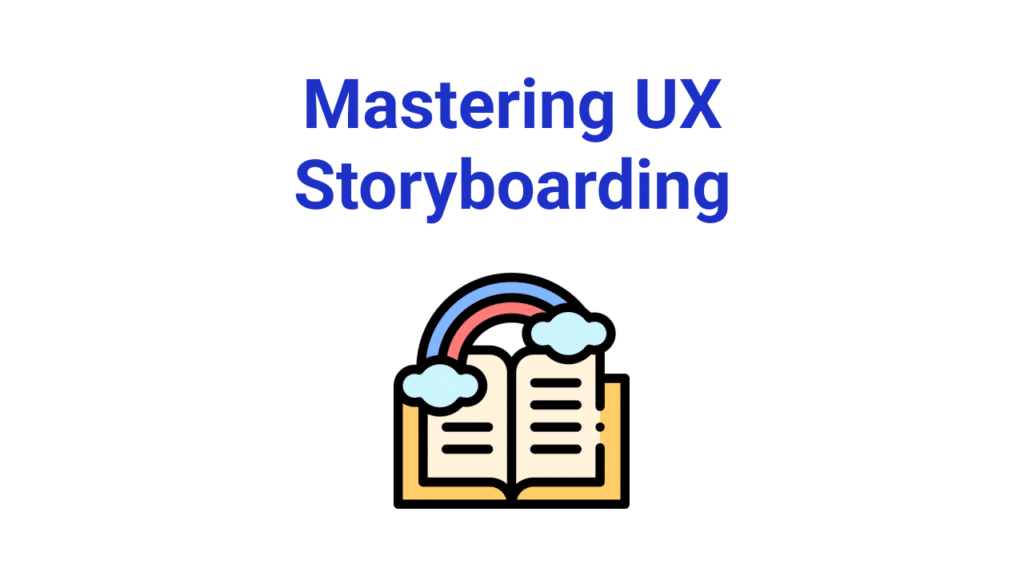Storytelling and its role in UX Design are critical to understanding user pain points and designing solutions that resonate with them.
This article is your official handbook for the go-to storytelling tool: UX storyboarding. By the end, you won’t only be a UX storyboarding master – you’ll be fully equipped to enhance your brand story.
What is UX Storyboarding?
UX storyboarding is the technique that creates sequential illustrations that depict a product or service’s user experience.
These illustrations will:
- Map out the user’s actions in chronological order, much like a comic strip
- Provide a clear depiction of their journey within a specific context or scenario.
Storyboards have nailed the ability to identify a product’s existing roadblocks and uncover opportunities to iron them out.
Stages of UX Storyboarding
Using storyboarding throughout multiple stages of UX/product design reveals its greatest virtues.
And these stages are:
- Post-User Research
Storyboards can supercharge your research data by extracting key themes that can actualize your findings into a visual user narrative. - Ideation Process
Storyboarding makes your brainstorming more effective – materializing these potential solutions so that you can assess their validity before you progress towards design and development. - Design Phase
Storyboards act as an infrastructure that keeps user pain points as the foundation of user-focused design decisions.
Benefits of UX Storyboarding
The human brain’s preference to process information visually rather than textually is what lets stakeholders communicate ideas quickly and collaboratively.
In other words, seeing is believing.
Research shows that “visuals are processed 60,000 times faster than text, and it takes twice as long to process and recognize words.”
The outcome?
A shared understanding of the problem space, and buy-in for your proposed design solutions.
Case Study: Successful Storyboarding in UX Design at AirBNB
Consider the success story of none other than the iconic home sharing platform, Airbnb;
“We use the storyboard to see how each moment in the journey connects and to understand where opportunities for improvement lie.
The storyboard is a benchmark we refer to, not only to gauge progress, but to help us look ahead and tackle potential problems down the road…
At Airbnb, we keep that mission in mind through a storyboard that depicts archetypal guest and host journeys.
Sharing this storyboard across departments reminds us that user experience is not just a design problem, but a whole company problem. Making it visual helps everyone stay on the same page while understanding each team’s individual roles in achieving our goals.”
Do these pillars of value sound familiar?
As we discussed earlier, real-life storyboarding serves as a:
- Point of reference for your user journey
- Vehicle to eliminate roadblocks in the way of delivering your solution
- Way to uncover opportunities for delighting users
- Tool for obtaining buy-in and support for your ideas
Tips for Creating Effective Storyboards
Jot down these tips for creating effective storyboards that solidify an understanding of your users:
- Keep it simple
Your storyboard should be easy to understand. Avoid unnecessary details that may confuse the viewer
- Focus on the user
The storyboard should center around the user’s experience, emotions, and actions
- Use a logical flow
Ensure that the storyboard follows a logical sequence of events
Common Mistakes to Avoid While Storyboarding
On that note, avoid these common pitfalls when creating your storyboard:
- Overcomplicating the story
Keep the story simple and focused; too many elements can distract from the main message
- Ignoring the User’s Perspective
Always design from the user’s point of view. Without it, your product risks straying far from being one that meets users’ needs
Digital Tools for Storyboarding
Your storyboarding process can be amplified by killer digital tools that structure and support it. There are even a plethora of templates built for this very niche:
-
- Figma (+ Official Figma Storyboard Template)
- Miro (+ Official Miro Storyboard Template)
- Mural (+ Official Mural Storyboard Template)
Final Cut
UX storyboarding’s cutting edge is the way it visually represents the user journey: leading to a finished product that conveys and delivers your brand story in full force.
So, what makes a good storyboard?
✔ Communicates the user journey effectively
✔ Highlights pain points
✔ Provides a clear-cut path to the winning solution
✔ A simple and logical user flow
Ready to tell your story? You now have everything you need for your first UX storyboard.
Happy storyboarding!



